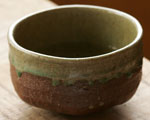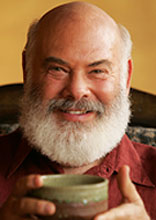Friday, May 27, 2011
Tuesday, May 24, 2011
Wednesday, May 18, 2011
Friday, May 13, 2011
ROME
This from the same guys that gave us the ridiculously cool HTML5driven "Wilderness Downtown". You'll be even more impressed by this one.
Thursday, May 12, 2011
The $300 House: Empowering the Poor
Get creative for a good cause.
Posted via email from Duovr
Monday, May 9, 2011
Saturday, May 7, 2011
Google Gets Richer: And Other Strange Things That Happen When Oil Prices Rise
McDonald's may have a way to redeem themselves and continue making everyone obese!!!
Posted via email from Duovr
Thursday, May 5, 2011
Meet Dr. Weil: My Life With Tea, Part Two - Dr. Andrew Weil

Green tea is preferred to other beverages because of its subtlety. In order to appreciate it fully, the mind must be quiet and free from distracting thoughts.
~The Venerable Sonhae SunimMy tea consumption is both formal and informal. Both have their rewards.
On the formal side, I have a bowl of matcha - made from powdered green tea that is the focus of the Japanese tea ceremony - every morning after breakfast. I certainly don't conduct a true tea ceremony every morning, but I take some care to prepare and consume my matcha in accordance with tradition as I have learned it in Japan.
First, I take out a beautiful, traditional hand-thrown tea bowl (chawan). I put the bamboo tea whisk (chasen) into it and pour in some warm water to soften the whisk and warm the bowl. I pour out the water, dry the warmed bowl, and use a bamboo scoop (chashaku) to put three scoops of matcha into the bowl. Then I add about a quarter cup of water warmed to 180 degrees - hot, but not boiling.
Finally I whisk the mixture to achieve what the Japanese call, "the froth of green jade," and to completely disperse the matcha. It does not take me long - perhaps 20 seconds - because I always pre-sift each new container of matcha upon opening to break up any lumps (I then store the matcha in my freezer to preserve freshness). Then I drink it, making audible slurps, as the Japanese do.
Tea does our fancy aid, repress those vapours which the head invade, and keeps that palace of the soul serene.
~Edmund Waller, "Of Tea"I take the act of drinking matcha seriously - or perhaps I should say, I take the pleasure of drinking matcha seriously.
So when I have my morning matcha, I don't simultaneously read the newspapers, surf the web, or even talk much with guests who may be present. The flavor of good matcha is subtle, nuanced, a harmony of gentle vegetal, floral, fruit and bitter notes that takes undivided attention to fully appreciate. There is a wonderful interplay here, because matcha contains psychoactive compounds - notably, caffeine and L-theanine - that promote calm, focused alertness, precisely the qualities required to appreciate the taste of good tea!
In the taste of a single cup of tea you will eventually discover the truth of all the ten thousand forms in the universe. It is difficult to put this taste into words, or even to catch a hint of it.
~The Venerable Kyongbong SunimWhen I drink green tea throughout the day, it is more informal. I usually have a good quality sencha - the daily, ordinary brewed green tea that is drunk throughout Japan - or gyokuru, a higher quality green tea that is shade-grown to both sweeten the taste and increase the L-theanine content. I also sometimes enjoy genmaicha, a combination of green tea and roasted, puffed brown rice that features a deeper, more earthy flavor. I brew these using loose tea, never bags, as I believe most teabags restrict some of the transfer of flavor and color. I variously use a small basket or a metal "tea ball" to hold the loose leaves. I drink these hot in the winter, and iced in the summer.
But I don't drink green tea exclusively. I have recently been exploring the world of oolong tea, which most Americans know only from the little pots of low-quality stuff offered in Chinese restaurants. Representing an intermediate stage of oxidation between that of green and black teas, oolong has a mystique and culture in China that is as rich as that of green tea in Japan, and the better qualities are delicious. I find many people in this country cling to green tea exclusively because they believe it alone is healthful, but oolong has similar antioxidant properties - explore!
Tea is liquid wisdom.
~AnonymousI am often asked for specifics regarding the brands and types of the teas that I drink. This can be challenging, as I am by nature an experimenter and seldom stay with one drink - or food, for that matter - indefinitely. For that reason, I suggest exploring and tasting on your own. A particular aid in the quest for a personal favorite tea can be the tastings held periodically at quality-focused tea shops that are springing up in many American cities such as San Francisco's Samovar Tea Lounges.
Having said that, here are some of my favorite brands and types:
- Prepared green tea: Ito En of Japan is the largest green tea company in the world, and since 2001 has been selling bottled and canned teas in the U.S. Its products represent excellent quality at a reasonable price. I partnered with Ito En to create "Sencha Shot" and "Oolong Shot," 6.4-ounce cans of unsweetened tea that are easy to take along in lunches or on hikes. (I donate all of my profits from royalties from sales of Ito En products directly to the Weil Foundation, a not-for-profit organization dedicated to supporting integrative medicine through training, education and research.)
- Bagged tea: Ito En also makes a line of teas that use a unique, flow-through large-mesh bag.
- Loose-Leaf sencha, gyokuro, genmaicha and oolong: I recommend sampling the various offerings of Ito En, In Pursuit of Tea and Japanese Green Tea Online.
- Matcha: I buy Zuisen No Shiro - the name means "Joyous Spring" - from Matcha and More, in economical 200-gram containers.
For more information for tea neophytes, I recommend, I "How to Get Into Tea" on Samovar's website. For more about matcha, see "Making Matcha Tea" by Kevin Rose, tea aficionado and founder of Digg.com.
Above all, make your tea drinking a happy affair, not another opportunity for stress and worry about "getting it right." Tea is a gentle, forgiving drink, adaptable to Zen monasteries and vending machines alike. Experiment, explore, enjoy!
Remember the tea kettle - it is always up to its neck in hot water, yet it still sings!
~Author UnknownRead part one of "My Life with Tea" here.
My Life With Tea, Part One - Dr. Andrew Weil

Drinking a daily cup of tea will surely starve the apothecary.
~Chinese ProverbI have written about the health benefits of green tea for more than 30 years, and it is possible that in some small way I have helped this wonderful beverage become popular in the United States. I hope so, because today, thousands of scientific studies confirm what the ancient Chinese knew through simple observation - green tea is perhaps the most healthful beverage human beings can consume. Studies either strongly suggest or confirm that the antioxidants in green tea can reduce LDL cholesterol, promote fat burning, reduce the risk of several forms of cancer, and alleviate depression.
But tea is much more than the healthful compounds in it. It is an experience, and for me, a personal story of discovery that continues to this day.
Tea is drunk to forget the din of the world.
~T'ien YihengWhen I was growing up in Philadelphia in the 1940s and 50s, my parents drank coffee exclusively - black and unsweetened. I did not like it (and still don't). The only tea we knew about was the stuff from the supermarket in tea bags. Old and sick people drank hot tea. My parents and I drank iced tea in the summer, much sweetened.
Then, after graduating from high school in 1959, I had a life-changing experience. As part of a remarkable institution known as the International School of America, I traveled around the world in nine months with a group of fellow students. In Japan, I was exposed to sencha - the everyday green tea drunk by all Japanese. More significantly, I experienced matcha, the powdered green tea, as part of a true Japanese tea ceremony. Many Americans have heard of, or even taken part in, this ceremony today, but in 1959, it was virtually unknown to most of the western world. The idea of using a food - tea - as a ceremonial object of focus and meditation fascinated me and made a strong impression.
Later on that same trip, I had a chance to drink tea in other Asian cultures as well as in middle Eastern and European countries, and by the time I returned to the U.S. to attend Harvard College, I was a confirmed tea aficionado and experimenter. In the early 1960s, I recall in particular a period of enthusiasm for lapsong souchong, a Taiwanese tea that is smoked over pinewood fires, imparting a rich, dark color and a complex, satisfying flavor.
If man has no tea in him, he is incapable of understanding truth and beauty.
~Japanese ProverbIn the 1970s and 80s, I became concerned about widespread coffee addiction in America. Many of my patients had longstanding disorders - such as chronic stress, insomnia, or gastrointestinal conditions - and had been to dozens of doctors, taken many medications, but found no relief. I was nearly always the only doctor who 1) asked them if they drank coffee, and 2) told them in no uncertain terms to stop drinking it for at least two months to see if the problem resolved.
This simple counsel was amazingly successful. My files are full of accounts of chronic health problems that resolved completely when people stopped drinking coffee. In many cases, these patients became tea drinkers, and found the experience satisfying and healthful.
Also in those decades, I went to Japan many times, and was fascinated by the true depth and richness of the green tea culture there. I became familiar with some of the finest varieties of green tea, and soon began to drink these daily.
I'll discuss what I drink, and why, in part two of "My Life With Tea."
Logos Redesigned For What The Company Actually Does
For fun and whimsy, graphic designer Viktor Hertz took a crack at reworking some famous company logos so they more accurately depict what the company is all about. C'mon, let's get real people. YouTube is not about putting "you" on the "tube" — it's the world's largest repository of cat videos! The rest of the satire, more of which can be found here, speaks for itself.
Honest logos [Behance]
More About:














